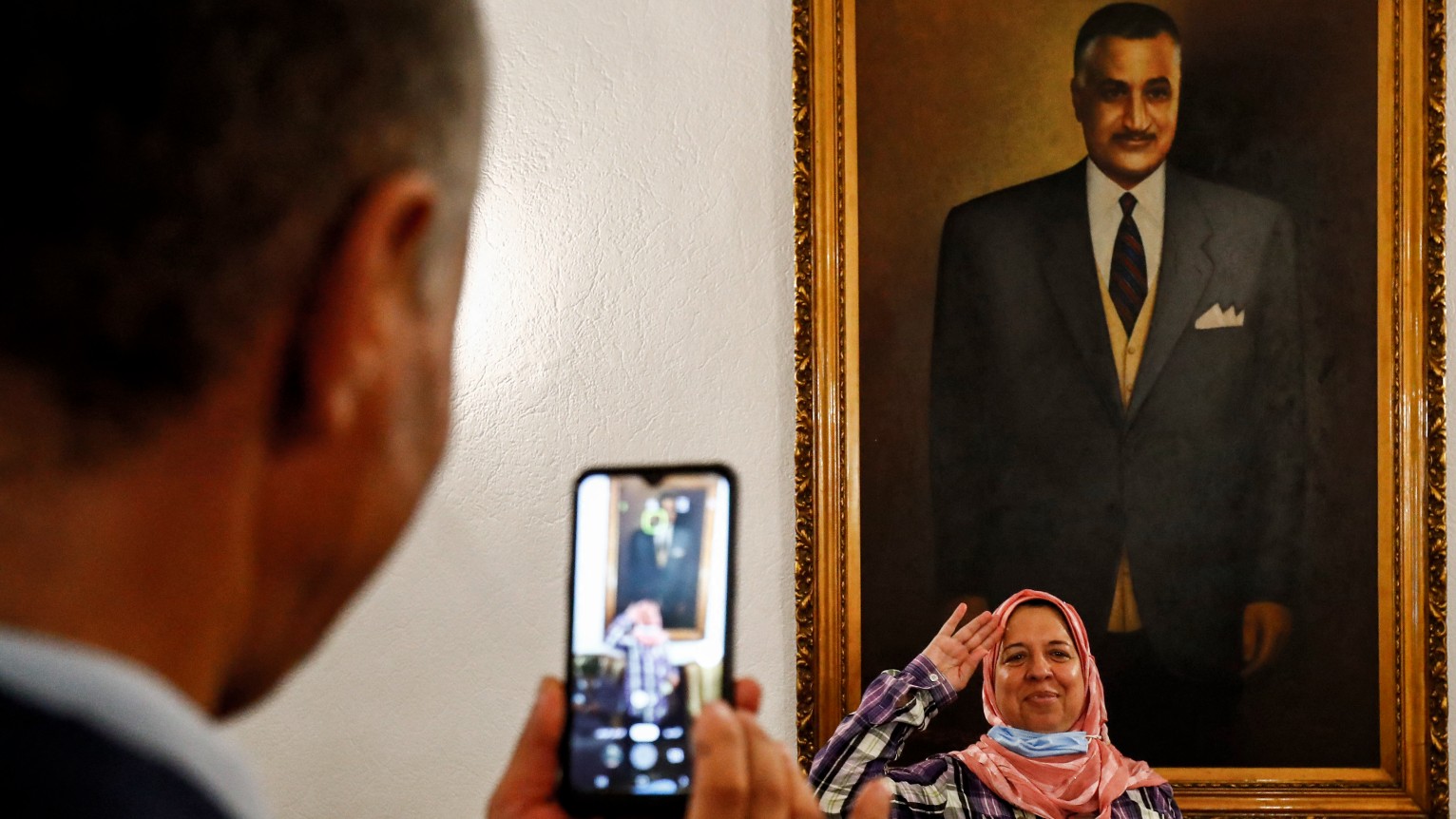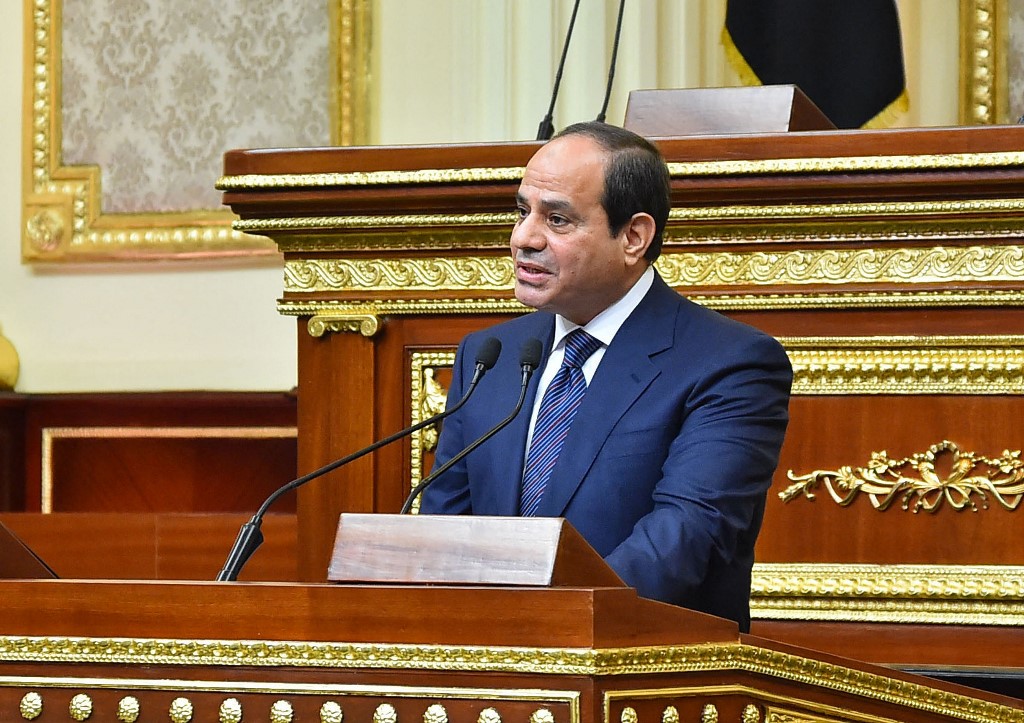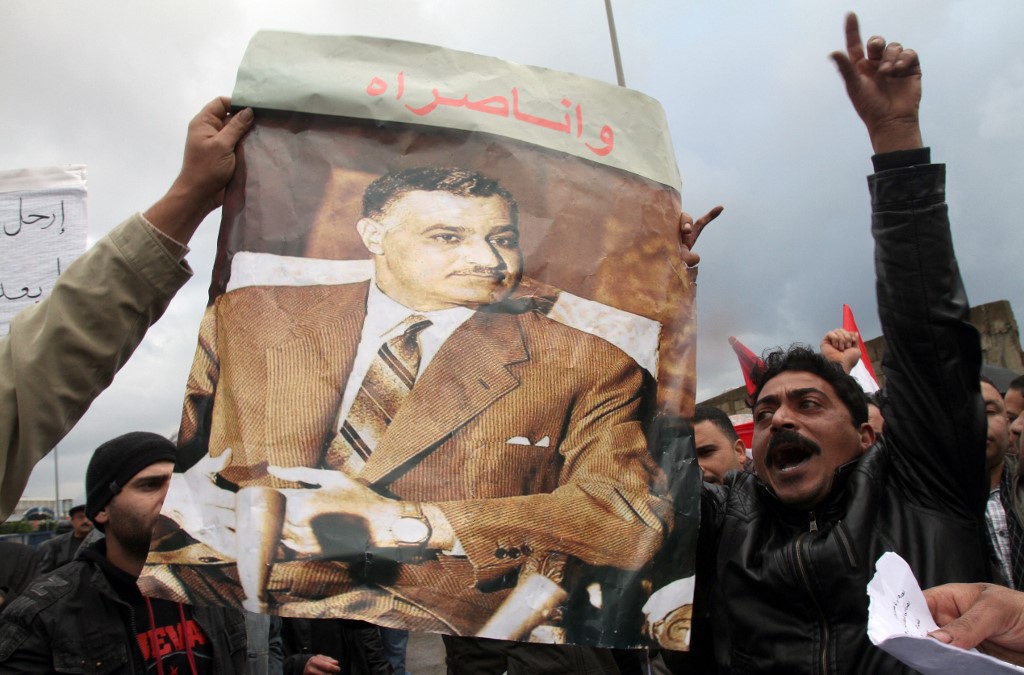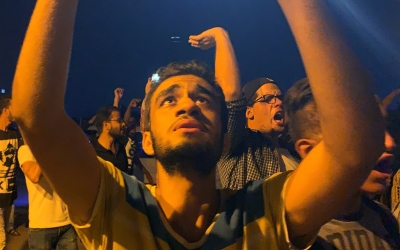More than 50 years after his death, Nasser is still present in Egyptian imagery.
His character is widely invoked, his legacy debated, his pictures raised, and his speeches circulated. Of all the Arab leaders of the past century, few had a lasting impact that extended to other Arab countries as had Nasser. His unparalleled position, still felt to this day, transforms him from history to memory, from the realms of political scientists to the works of writers and artists – in short, from a real figure to a metaphor.
Whether glorified or demonised, elevated or debased, hailed as a symbol of freedom, anti-colonialism and social justice, or tarnished as a ruthless dictator who cultivated a personality cult and popularised the authoritarian model of regimes among Arabs, Nasser is an emotional and divisive subject, an agglomeration of meanings that transcend the direct outcomes of his rule to dwell deeply in the psyche of generations of Egyptians and Arabs, becoming a site on to which they project their dreams and aspirations, defeats and disappointments.
Those who no longer believe in the ‘individual hero’ are liberated from a grand delusion but they still cannot fill the vacuum that is left by Nasser
In his attempt to analyse the Nasserite ideology, Egyptian historian Sherif Younis concludes by arguing that detractors of Nasser as well as his panegyrists testify to the perennial omnipresence of the president in Egyptian life.
For Younis, Nasser is the ultimate materialisation of the notion of the “saviour”, the dream that is so ingrained in the Egyptian imagination. Why cannot even those who realise the falsity of this concept “leave Nasser in his tomb and transcend him?” asks Younis.
His argument is that Egyptians have yet to produce an alternative political model that can replace Nasser’s. Those who no longer believe in the “individual hero” are liberated from a grand delusion but they still cannot fill the vacuum that is left by Nasser, the supreme representative of that model.
In other words, for Egyptians to cease invoking Nasser and his associations and consider him part of a distant past, a drastic change must occur to the way they conceive of themselves vis-a-vis their reality, history, and nation state – a transformation of their social imaginary.
Multiple junctures
I have sought in my book to identify the exact space that Nasser has occupied in the Egyptian imaginary, its histories, trajectories, forms, particularities, and vicissitudes. It has tried to show that the image of Nasser has not taken a smooth, uninterrupted, singular path of glory or disrepute. Rather, it passed through multiple junctures and turning points, and was produced by several contesting narratives, divergent opinions, and conflicting sensibilities.
The largely positive, romantic view of Nasser that has proliferated in Egyptian literature and film in the last two decades hides behind it a much more complicated and multilayered tale of rise and fall.
In fact, the survival of Nasser as a site of nostalgia for many Egyptians is in itself indicative of the peculiar position in which he was placed, given the disgracing blow that he received in 1967 and the intense campaign of de-Nasserisation that was launched by his successor.
A major contribution of this book lies in unearthing the ways in which many Egyptians separate Nasser from his regime. While the latter can be seen as oppressive, unjust, and even brutal, Nasser is often detached from its excesses and therefore exonerated as either unknown or necessarily disapproving these measures.
Egyptian literature and film abound with characters that claim Nasser to their side and invoke him against his very regime, empowered by a certain belief in his exceptionalism
Egyptian literature and film abound with characters that claim Nasser to their side and invoke him against his very regime, empowered by a certain belief in his exceptionalism.
One of the remarkable outcomes of this tendency is that, even among the films that belonged to the de-Nasserisation phase, Nasser himself was hardly criticised, and his portrait, for that matter, rarely appeared in the rooms where interrogation and torture took place.
By attempting to delineate “plots” that informed these representations, one could speak of a periodisation of Nasser’s images from 1952 onwards, resulting in certain stages, each of which was marked by a dominant approach towards Nasser.
Whereas the four years that preceded the 1956 Suez War saw writers producing mild criticism of Nasser and showing anxiety about the repressive measures that were initiated by him – while, at the same time, acknowledging his good intentions and sincere efforts to improve the country – the period between 1956 and 1967 largely witnessed a Nasser glorified, a symbol declared hero of independence, anti-colonialism, and social justice who, if presiding over a regime in which torture, corruption, and persecution may have taken place, can nonetheless be separated from those misdeeds and claimed by the people.
This long period of belief in Nasser was interrupted by the 1967 naksa (defeat), which caused a rift among writers and filmmakers regarding Nasser’s own culpability for the disastrous defeat. Thus came three years of disenchantment with Nasser that were interspersed with harsh allegorical cinematic and literary treatments of him, some of which questioned the previous separation between Nasser and the regime, culminating with Husayn Kamal’s movie Shay’ min al-Khawf (A Taste of Fear) in 1969.
Between Nasser and Sadat
The negative representations of Nasser reached their acme during Sadat’s regime (1970-81), with a systematic attack on his legacy that sought to reduce it to scenes of torture, fear, and oppression. This attack was meant to establish a contrast between Nasser and Sadat and, therefore, to bestow legitimacy over the radical changes that Sadat introduced in the economic, political and social directions of Egypt.
A close examination of this period shows, however, that these representations were found mainly in films, and that most literary narratives (with a notable exception in Mahfouz’s Al-Karnak) remained silent towards a reappraisal of the image of Nasser in the 1970s. Whereas the majority of writers shared Nasser’s class orientations and his ideals of social justice and equality, films came largely out of the private sector and were ruled by its values and its stance towards Nasser.
Unlike writers who witnessed a collapse of the Nasserite project at the hands of Sadat, a sizable number of film producers found in this decade a golden opportunity to release the enmity that they had been harbouring over the years towards Nasser and his socialist policies.
Yet the deterioration in the economic and social situation that was felt strongly in the last years of Sadat, and persisted throughout President Hosni Mubarak’s Egypt, initiated a positive comeback of Nasser’s image that began in the early 1980s and dominated the ensuing years.
Interestingly, this favourable return of Nasser nearly eliminated the divergence that was recognised in the previous decade between writers and film-makers, and united them both in invoking Nasser against a sinking reality.
Thus Nasser became a martyr in Gamal al-Ghitani’s Al-Tajalliyat and a resort to the poor Zeinat in Salwa Bakr’s Zeinat fi Janazat al-Ra’is, while a group of young, politically progressive filmmakers began to revisit the image of Nasser cinematically and to dismiss the sensational treatment of their 1970s predecessors.
The resurgence of a predominantly nostalgic view of Nasser in the last two decades is more informative about the situations surrounding this resurgence in Egypt than about the president.
That many Egyptians still yearn for the same ideals, dreams and aspirations that Nasser had striven to realise very much indicates that Egypt has experienced a post-Nasser era only temporally. Poverty, social injustice and foreign hegemony have so much permeated the country that they became stable components of Egyptian life.
Still worse, the waves of Islamic extremism, sectarian clashes, and migration of major intellectuals, from which Nasser’s Egypt was largely free, were only a few of the symptoms of a decaying reality.
In addition, the untimely death of Nasser in 1970 befell a nation still traumatised by an unprecedented, demeaning defeat whose images and memories never cease to haunt the Egyptian imaginary.
Only when Egyptians are truly awakened from that nightmare can 1967 lose part of its damaging associations and become a distant moment in a bygone era. The achievements of the Egyptian army during the 1973 October War presented a potential remedy that was soon aborted by Sadat’s political and economic policies. Strikingly, the October War has yet to be warmly embraced and represented by Egyptian writers and film-makers.
2011: Nasser still relevant
This book was conceived almost a year before the 2011 Egyptian revolution, and all the works that the previous chapters discuss predate it. Naturally, it is still too early to offer a definitive answer to whatever impact the recent tumultuous events in Egypt will have on the image of Nasser and his meaning for Egyptians.
In fact, the revolution itself, continuing as it is, is still scarcely portrayed in written or visual narratives. Ahdaf Soueif (b. 1950) offers an analysis of this situation in an article that is tellingly titled, “In Times of Crisis, Fiction Has to Take a Back Seat”. Published in August 2012, the article argues that the time has not yet come to produce a mature fictional account of the revolution.
If Egyptian novelists “produced texts of critique, of dystopia, of nightmare” before the revolution, it seems as though they all “have given up – for the moment – on fiction”. The 2011 revolution is not fictionalisable yet because “the immediate truth is too glaring to allow a more subtle truth to take form. For reality has to take time to be processed, to transform into fiction.”
Another reason may lie in the fact that writing a novel necessitates a time of withdrawal from the real world and turning inwards, isolating oneself far from the crowds that are occupying the streets.
And it is here that Soueif, herself both a prominent novelist and a participant in the revolution, favours political activism over fictional production, or the citizen over the novelist: “You, the citizen, need to be present, there, on the ground, marching, supporting, talking, instigating, articulating.”
Though written more than three years ago, Soueif’s insights have proved to be largely true; seldom has any major literary figure in Egypt produced a significant work concerning the 2011 revolution and its consequences.
That Nasser has been present in the 2011 revolution, however, is abundantly documented. I began the Introduction with an actual incident that speaks of the continuing relevance of Nasser in Egyptians’ lives.
The images from Tahrir Square which were circulated around the world included groups of Egyptians carrying pictures of Nasser, while live testimonies told of the existence of several booths at Tahrir that broadcast his speeches and well-known songs that were dedicated to him.
Since 2011, one can speak of three major phases that have underscored the pertinence of Nasser to current events in Egypt. The first phase ushered in vibrant debates concerning the position that Nasser held vis-a-vis the 2011 revolution.
The main question which dominated these debates centred on whether the 2011 revolution signified a rupture with the 30 years of Mubarak, with Sadat’s Egypt, or with the entire July 1952 regime – whether, that is, the contemporary Egyptian revolutionaries were a continuity or a discontinuity with Nasser.
Egyptian journalist Nagla’ Bidir, for instance, warned at the time when Egypt was ruled by the Supreme Council of the Armed Forces (SCAF), against homogenising the Egyptian military and perceiving it as a single entity since Nasser, arguing that the last is not part of “the rule of the military” against which revolutionaries were protesting.
Egyptian film-maker Khalid Youssef speculated that the positive image of Nasser would gain new momentum in Egyptian cinema following the revolution, while novelists Sonallah Ibrahim, Ibrahim Abdel Meguid, and Gamal al-Ghitani unanimously declared the revolution as a major incident against Nizam Yulyu (the July Regime).
In addition, an exhibition which opened a few days before Nasser’s first post-revolution birthday attracted wide attention and underscored a public divide with regard to the memory of the president. Entitled “Nasser, the Dream”, the exhibition, whose opening was attended by none other than Nasser’s family, featured old and new paintings, including a few that were created after the 2011 revolution, but all demonstrating “the bright side of the picture”, as the title of one critical review put it.
Published in al-Ahram Weekly, the review criticised the organisers for attempting to link Nasser to the 2011 revolution, wondering,
If Nasser should be the symbol of dreams of justice, freedom, and equality among people both rich and poor, then why on earth are we still suffering from injustice and lack of freedom in Egyptian society? And if the principles of the 1952 Revolution have failed to survive, then why are we still celebrating the dream? The dream, in other words, that turned out to be a nightmare.
Similarly, Nasser featured in two of the early literary responses to the 2011 revolution. The Gabriel Garcia Marquez-like title Mi’at Khatwa min al-Thawra (One Hundred Steps of the Revolution) introduces a diary that adopts an ambivalent stance towards the relationship between Nasser and Tahrir’s revolutionaries.
The writer, who chronicles his personal observations of the 18 days of protest leading to the fall of President Mubarak, oscillates between portraying the masses in Tahrir as “chanting from their wounded dignity against thirty years of the dictator’s rule” and unequivocally announcing “the regime of the July revolution is 62 years old … This revolution is a total rupture with it.”
The fear of the Muslim Brotherhood and the ancien regime had certainly driven many voters to search for a third way
Far more significant was the comparison between Nasser’s resignation speech in the wake of the 1967 defeat and Mubarak’s second speech on 1 February 2011, which occurred between a mother and her son Khalid, in Hisham al-Khishin’s novel 7 Ayyam fi al-Tahrir (Seven Days at Tahrir).
Known for its powerful, emotional impact on a large number of Egyptians during the revolution – creating a division between those who believed in Mubarak’s concessions and the promises he made and those who did not – the speech convinced Khalid and his friends to leave Tahrir and give Mubarak the interim he requested.
Khalid’s mother, however, reminds her son of what she sees as a manipulation of Egyptians similar to that practised by Nasser, thus establishing continuity between the two presidents:
Your enthusiasm, Khalid, reminds me of the days when Nasser resigned. One speech made these kind people fill the streets, begging him who led them to defeat and disgrace to stay. All of the Egyptian leaders understand the emotional nature of the Egyptian public, and they seek to exploit it for their interests.
A new Nasser: Sabahi or Sisi?
The second phase coincided with the astounding rise of Hamdeen Sabahi, which has undeniably reinvigorated questions concerning the place of the charismatic leader in post-2011 Egypt.
A lifelong Nasserist, Sabahi was the dark-horse candidate of the 2012 Egyptian presidential election, surprisingly finishing third by a narrow margin behind the Muslim Brother and eventual winner Mohamed Morsi and the Mubarak-era prime minister Ahmad Shafiq.
Described by many observers as a politician in the style of Nasser, Sabahi did not hide his political inclinations, building as he did on his hero’s appeal towards the masses. He sought to maintain his own vision of the presidency, however, attempting to avoid what he perceived as the pitfalls of Nasser: “I would uphold Nasser’s principles on social justice while pushing for a completely democratic system that clearly defines and limits the role of the president, which Nasser did not do.”
Nowhere can the relevance of Nasser and the power of his image be better recognised than with the rise to power of Abdel Fattah el-Sisi
The phenomenon of Sabahi cannot be attributed solely to Egyptians’ yearning for a Nasser-like leader – the fear of the Muslim Brotherhood and the ancien regime had certainly driven many voters to search for a third way. Yet his presence served as an initial, if not foreshadowing, reminder of the image of Nasser and its unceasing allure for ordinary Egyptians.
Nowhere can the relevance of Nasser and the power of his image be better recognised, however, than with the rise to power of the former minister of defence, Abdel Fattah el-Sisi.
In a very well-known episode, the Egyptian army intervened yet again in the political sphere, following days of massive protests against President Morsi. On 3 July 2013, el-Sisi, then the chief of the army, removed Morsi from power in what came to be disputed as either a coup or a second revolution.
Almost a year later, Sisi, rescinding his initial decision not to run for president, unsurprisingly won the presidential election against none other than Sabahi himself, this time, however, with a much bigger margin (96.91 per cent). With the emergence of Sisi and the inauguration of what Juan Cole described as “Sisi-mania”, Nasser resurfaced in Egyptian life, perhaps unprecedented in the last decade.
News channels broadcast images of thousands of Egyptians carrying posters that featured both Nasser and Sisi; some of the country’s leading intellectuals, such as Sonallah Ibrahim and Gamal al-Ghitani, praised Sisi and labelled him as a continuation of Nasser; and Sisi himself, in various situations and interviews, has capitalised on this comparison and appeared rather flattered and humbled by it.
Any Google search on the comparison between the two men will result in tens of hits, both in Arabic and English, covering a wide range of media, from songs to videos to newspaper op-eds and features, hotly engaging in a debate concerning the falsity or authenticity of this comparison.
This recent Sisi-Nasser phenomenon, though unfinished and still unfolding, does nevertheless compel us to reflect on the prospects of the location of Nasser in the Egyptian imaginary. First, the strong resurrection of Nasser and his legacy in the past two years tells more about Egyptians than about Sisi himself.
Up to his intervention in July 2013, Sisi was almost unknown to ordinary Egyptians. Situating his photographs next to Nasser’s within a few months of his rise to power is a form of wishful thinking, undoubtedly speaking to Egyptians’ longing for a Nasser-like figure on whom they could rely and in whom they might find solutions to the many difficult circumstances engulfing them.
A few voices within the Brotherhood sought to shatter the comparison between Nasser and Sisi, considering it a fake attempt to legitimise an otherwise illegitimate usurper of power
As mentioned earlier, the initial months following the 2011 revolution had left Egyptians pondering the possibility of transcending the need for a strong leader and fashioning a new social contract whereby the military would enjoy a very limited role in public life.
Sisi-mania, however, offered a more definitive answer to this. No matter how much it was orchestrated by Egypt’s official media outlets and personalities, it was still undeniable that the Sisi-Nasser comparison touched upon certain nostalgic feelings among Egyptians.
The associations that Nasser evoked in ordinary Egyptians proved yet again to be a decisive factor which his successors could continue to appropriate, falsely or otherwise.
Second, it is telling to note the way in which Nasser was claimed and appropriated by the official Egyptian media, businessmen, and Sisi’s entourage. Largely consisting of figures whose social, political and economic orientations are antagonistic to Nasser’s, this influential segment of Egyptian society was nonetheless capable of selecting a few aspects of Nasser through which they could announce Sisi to be his true inheritor – the most important of which was, undoubtedly, both men’s crushing of the Muslim Brotherhood.
As many observers have noted, “the upper class and upper-middle class that are currently calling al-Sisi as the new Nasser and cheering for him will not tolerate accepting Nasser’s social and economic policies once again in Egypt”.
Interestingly, Nasser became a floating signifier, a confusion of references whose determinate signification relies not so much on what he did exactly and called for as it did on the power of those who capitalise on his image.
This is not to homogenise the entire sector of Egyptian society who adopted this view of Sisi as a new Nasser and render them essentially anti-Nasser – a sizeable number of those included renowned leftist intellectuals and activists in Egypt – it included members of Nasser’s own family.
Rather, it is to note how Nasser can be fragmented into multiple Nassers, each serving the needs of different sectors of Egyptian society.
Third, the 2014 presidential election in Egypt was yet another manifestation of Nasser’s relevance in today’s Egypt and the apex of claiming Nasser as a way to appeal to ordinary Egyptians. If the 2012 election had pitted the self-declared Nasserist Hamdeen Sabahi against a Muslim Brother and a Mubarak era figure, its 2014 counterpart witnessed Sabahi running against Sisi or, as one could perhaps put it, Nasser against Nasser.
While the two candidates sought Nasser and his legacy as a way to bestow legitimacy on their projects and blueprints, backed, if disproportionately, by legions of media outlets and personalities, they both opted for the Nasser that suited their interests the most. Eventually, and rather to be expected, the strong, militant nemesis of the Muslim Brotherhood, Nasser as exemplified by Sisi, triumphed over the socialist version of Nasser that was promoted by Sabahi.
Fourth, although the dominant narrative among the Muslim Brotherhood, both in Egypt and outside, was to view their plight at the hands of Sisi as a reincarnation of their bloody conflict with Nasser in the 1950s and 1960s, a few voices within the Brotherhood sought to shatter the comparison between Nasser and al-Sisi, considering it a fake attempt to legitimise an otherwise illegitimate usurper of power.
Tellingly, Nasser, a historic enemy of the Brotherhood, was partly redeemed, not so much in order to revisit the Brotherhood’s perspective on him as it was to further condemn Sisi and single him out as a ruthless tyrant unprecedented in Egyptian history. Thus, Yasir Abu Hilala, then director general of Al Jazeera, established in an op-ed published in 2014 what he believed were nine differences between Nasser and Sisi, arguing that the only thing the two men had in common was the military uniform.
As mentioned earlier, the dramatic comeback of Nasser since 2013 attests to his powerful image and its ability to haunt the Egyptian imagination at such a critical moment in Egyptian history.
Whether Sisi’s performance will have an impact on Egyptians’ remembering of Nasser is left to speculation. While Sisi’s failures, easily noted by now, may lead ordinary Egyptians to abandon the notion of the saviour and dissociate it from their aspirations for a better future, it could nonetheless add more to the exceptionality of Nasser, elevating him to an unparalleled position that neither Sisi nor any other political figure could attain.
It could prove, yet again, that, for many Egyptians, Nasser is not only a historical figure – a leader who ruled over Egypt at a certain time in their distant past, succeeding occasionally and stumbling at many other times – but rather an idea, a synonym for social justice, dignity and equality.
Will these associations run their course and eventually lose their spark in Egypt? Possibly. But until then, Nasser, as the previous chapters have made clear, continues to be an essential component of the Egyptian imaginary.
The above was excerpted with the author’s permission from Nasser in the Egyptian Imaginary (2016) by Omar Khalifah.
The views expressed in this article belong to the author and do not necessarily reflect the editorial policy of Middle East Eye.
Post Disclaimer
Disclaimer: Why Nasser's legacy still preoccupies the Egyptian psyche by Omar Khalifah - Views expressed by writers in this section are their own and do not necessarily reflect Latheefarook.com point-of-view







